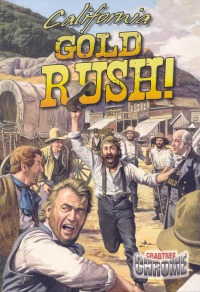| ________________
CM . . .
. Volume XX Number 26. . . .March 7, 2014 
 |
California Gold Rush! (Crabtree Chrome).
Robin Johnson.
St. Catharines, ON: Crabtree, 2014.
48 pp., pbk., hc., pdf & html, $11.95 (pbk.) $21.56 (RLB.).
ISBN 978-0-7787-1178-0 (pbk.), ISBN 978-0-7787-1170-4 (RLB.), ISBN 978-1-4271-8931-8 (pdf), ISBN 978-1-4271-8923-3 (html).
Subject Headings:
Gold mines and mining-California-History-19th century-Juvenile literature.
Frontier and pioneer life-California-Juvenile literature.
California-Gold discoveries-Juvenile literature.
California-History-1846-1850-Juvenile literature.
Grades 3-6 / Ages 8-11.
Review by Ian Stewart.
**** /4
|
| |
|

excerpt:
On January 24, 1848, James W. Marshall was standing in a river when something shiny caught his eye. Gold! Suddenly the rush was on. People from around the world came to California by the thousands in ships and wagons. They were determined to find gold and get rich—or die trying.
From 1848 to 1855, about 300,000 people took part in the California Gold Rush. They worked hard and fought for their fortunes. Some got lucky and struck gold. Many left broke and empty-handed. All had tales to tell of the Wild West and its treasures.
California Gold Rush is yet another title in Crabtree’s excellent “Chrome” series. This series of high interest titles is designed for middle-years students who are reading at Fontas and Pinnell levels L- M or Reading Recovery/ PM Benchmark equivalent levels, 19-20. However, the high quality of the book’s writing, structure and detail make the title appropriate for higher level readers.
Following the Mexican-American War, California became part of the United States in February 1848, and later that same month gold was discovered at Sutter’s Mill. The great California gold rush was about to begin. Between 1848 and 1855, hundreds of thousands of men, from all parts of the world, packed up their belongings and headed for the goldfields hoping to “strike it rich” but very few did. They braved the dangers of a long sea journey or the perils of travelling across America in wagon trains. When they reached California, there were no houses for them, and many slept on the hard ground.
When the gold rush began, life in California was rough and tumble. There was no real government, nor laws; disputes were settled with fists or at the end of a gun barrel. The first prospectors, known as the “49ers”, “staked out” their claims. Some of them found plenty of gold, and one miner wrote in a letter, “Your streams have minnows and ours are paved with gold.” However, students learn that working a claim was backbreaking physical labour, and they will learn the methods the miners used to find the gold.
The great gold rush was only six years in duration; however, within those short years, California gained statehood, the population grew, the transcontinental railway was begun, and small towns like San Francisco turned into thriving cities. Because the rich soil and temperate climate were ideal for farming, new settlers flocked to fertile valleys, and, still today, people look to California as a place to have their dreams fulfilled.
As the California gold rush abated, prospectors looked for riches in the far-flung gold fields of Australia, New Zealand, British Columbia and in Yukon.
Highly Recommended.
Ian Stewart teaches at Cecil Rhodes School in Winnipeg, MB.

To comment
on this title or this review, send mail to cm@umanitoba.ca.
Copyright © the Manitoba Library Association. Reproduction for personal
use is permitted only if this copyright notice is maintained. Any
other reproduction is prohibited without permission.
NEXT REVIEW |
TABLE OF CONTENTS FOR THIS ISSUE
- March 7, 2014.
AUTHORS |
TITLES |
MEDIA REVIEWS |
PROFILES |
BACK ISSUES |
SEARCH |
CMARCHIVE |
HOME |
